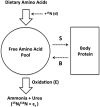Historical and contemporary stable isotope tracer approaches to studying mammalian protein metabolism
- PMID: 27182900
- PMCID: PMC5763415
- DOI: 10.1002/mas.21507
Historical and contemporary stable isotope tracer approaches to studying mammalian protein metabolism
Abstract
Over a century ago, Frederick Soddy provided the first evidence for the existence of isotopes; elements that occupy the same position in the periodic table are essentially chemically identical but differ in mass due to a different number of neutrons within the atomic nucleus. Allied to the discovery of isotopes was the development of some of the first forms of mass spectrometers, driven forward by the Nobel laureates JJ Thomson and FW Aston, enabling the accurate separation, identification, and quantification of the relative abundance of these isotopes. As a result, within a few years, the number of known isotopes both stable and radioactive had greatly increased and there are now over 300 stable or radioisotopes presently known. Unknown at the time, however, was the potential utility of these isotopes within biological disciplines, it was soon discovered that these stable isotopes, particularly those of carbon (13 C), nitrogen (15 N), oxygen (18 O), and hydrogen (2 H) could be chemically introduced into organic compounds, such as fatty acids, amino acids, and sugars, and used to "trace" the metabolic fate of these compounds within biological systems. From this important breakthrough, the age of the isotope tracer was born. Over the following 80 yrs, stable isotopes would become a vital tool in not only the biological sciences, but also areas as diverse as forensics, geology, and art. This progress has been almost exclusively driven through the development of new and innovative mass spectrometry equipment from IRMS to GC-MS to LC-MS, which has allowed for the accurate quantitation of isotopic abundance within samples of complex matrices. This historical review details the development of stable isotope tracers as metabolic tools, with particular reference to their use in monitoring protein metabolism, highlighting the unique array of tools that are now available for the investigation of protein metabolism in vivo at a whole body down to a single protein level. Importantly, it will detail how this development has been closely aligned to the technological development within the area of mass spectrometry. Without the dedicated development provided by these mass spectrometrists over the past century, the use of stable isotope tracers within the field of protein metabolism would not be as widely applied as it is today, this relationship will no doubt continue to flourish in the future and stable isotope tracers will maintain their importance as a tool within the biological sciences for many years to come. © 2016 The Authors. Mass Spectrometry Reviews Published by Wiley Periodicals, Inc. Mass Spec Rev.
Keywords: mass spectrometry; protein metabolism; stable isotopes.
© 2016 by The Authors. Mass Spectrometry Reviews published by Wiley Periodicals, Inc.
Figures





References
-
- Abian J. 1999. The coupling of gas and liquid chromatography with mass spectrometry. J Mass Spectrom 34:157–168.
-
- Addona TA, Abbatiello SE, Schilling B, Skates SJ, Mani DR, Bunk DM, Spiegelman CH, Zimmerman LJ, Ham AJ, Keshishian H, Hall SC, Allen S, Blackman RK, Borchers CH, Buck C, Cardasis HL, Cusack MP, Dodder NG, Gibson BW, Held JM, Hiltke T, Jackson A, Johansen EB, Kinsinger CR, Li J, Mesri M, Neubert TA, Niles RK, Pulsipher TC, Ransohoff D, Rodriguez H, Rudnick PA, Smith D, Tabb DL, Tegeler TJ, Variyath AM, Vega‐Montoto LJ, Wahlander A, Waldemarson S, Wang M, Whiteaker JR, Zhao L, Anderson NL, Fisher SJ, Liebler DC, Paulovich AG, Regnier FE, Tempst P, Carr SA. 2009. Multi‐site assessment of the precision and reproducibility of multiple reaction monitoring‐based measurements of proteins in plasma. Nat Biotechnol 27:633–641. - PMC - PubMed
-
- Anonymous. 1815. On the relation between the specific gravities of bodies in their gaseous state and the weights of their atoms. Ann Philos 6:321–330.
-
- Aston F. 1919a. Neon. Nature 104:334.
-
- Aston F. 1919b. LXXIV. A positive ray spectrograph. Philos Mag Ser 6, 38:707–714.
Publication types
MeSH terms
Substances
Grants and funding
LinkOut - more resources
Full Text Sources
Other Literature Sources
Research Materials
Miscellaneous

